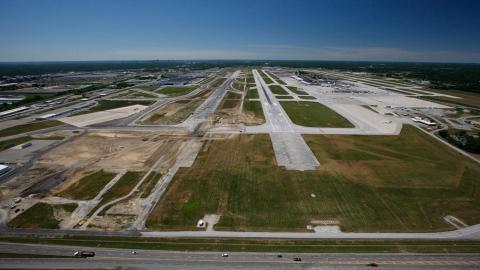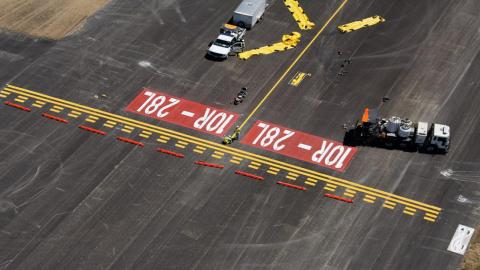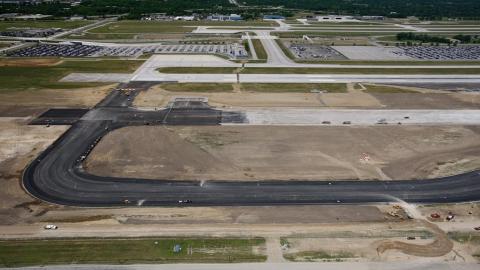
In early 2009, we began the design for the construction of a new 10,113-foot-long by 150-foot wide runway complex at Port Columbus International Airport (CMH).
The overall program included the establishment of a replacement runway located approximately 702 feet south of the current runway, a new parallel taxiway located to the south of the relocated runway and associated entrance, and exit and high-speed exit taxiways to connect the new facility to the existing airfield.
The program also included converting the existing runway to a parallel taxiway and the replacement of associated navigational aids (NAVAIDs) and visual aids to achieve special authorization Category II instrument landing system capability.
With a focus on sustainability, our design ultimately delivered the first all, high-intensity light emitting diode (LED) -lamped runway complex in the U.S. and a host of other triple-bottom-line benefits.
-
150
foot-wide, 10,113-foot-long runway is located in the remnants of the former Air Force Plant 85
-
60 %
power usage reduction expected through use of LED lighting
-
185 K
cubic yards of demolition waste diverted from disposal in landfills and incinerators
-
290
acres (approximately) of planted grass seed – enough to reseed The Ohio State University football stadium more than 200 times
“This is the largest capital project in our history. Port Columbus International Airport is a key transportation hub for connecting Central Ohio with the world. With the opening of our new runway, the Columbus Regional Airport Authority is continuing its commitment to providing passengers, businesses and the community the highest level of service, safety, satisfaction and economic benefit.”
A sustainable and award-winning success
In early 2009, we began the design for the construction of a new 10,113-foot-long by 150-foot wide runway complex at CMH.
Focusing on the triple-bottom-line – or considering social and environmental factors as well as economic factors – guided our team’s entire sustainable design effort. Specifically, we focused on ensuring compatibility of all used materials with the natural environment, reducing pollution during construction and after commissioning, reusing existing resources, optimizing operations thereby reducing emissions and improving safety and delays, supporting economic needs and securing the most cost-efficient options.
It’s through this focus that we helped CHM’s Runway 10R-28L become the first runway in the U.S. to employ high-intensity LED runway edge lights – achieving an expected 60 percent power usage reduction. This solution also reduced the runway’s light maintenance costs – incandescent lights have an annual lamp replacement, while LED lights have a ten-year life expectancy.
Additionally, we reclaimed construction waste and suitable bituminous pavements for embankments and aggregate base courses, diverting about 185,000 cubic yards of demolition waste from disposal in landfills and incinerators, resulting in greatly reduced project costs during the wettest year in Columbus history.
At the end of the program, we removed more than 15 acres of impervious area from the existing site, reducing the quantity of stormwater runoff on the airport and increasing water quality. To alleviate flooding problems located at points downstream of airport property, our team diverted more than 100 contributory acres from the problematic watershed to the watershed containing the newly constructed stormwater management basin.
Our drainage design also reduced the peak flow rates post-development to below the pre-development conditions. By utilizing above and below ground storage, we eliminated the need for construction of a $4.5 million stormwater detention basin.
The preliminary design documents projected construction of the new runway complex and stormwater management basin would generate over 400,000 cubic yards of earthen waste material. During design, we developed detailed vertical alignment and grading alternatives to optimize the material within the project site and avoid disturbance of other sites.
With the implementation of the multitude of sustainable solutions, the Runway 10-R 28L project became the first ever airfield project to win the Airports Council International North America Environmental Achievement Award, which recognizes airports that strive to protect and preserve the environment through dedicated programs, initiatives and projects. In addition to this first-of-its-kind award, the project received the 2013 Quality Award for Asphalt Paving from Flexible Pavements of Ohio and the Best Project acknowledgement by the 2014 Illuminating Engineering Society Aviation Lighting Committee.

















































